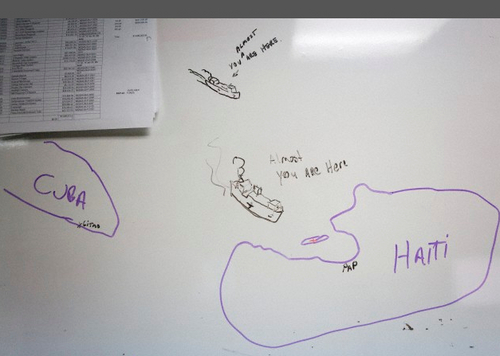As information regarding January 12th’s earthquake in Port au Prince and its subsequent after shocks becomes available the staggering toll that this catastrophe will yield on Haiti is slowly starting to settle in. Each day the death toll–real and projected–rises to a new alarming height, the forecast for rebuilding this city, much less Haiti as a whole becomes incredibly daunting, and the lessons learned all the more grave. With over a century of political mismanagement one can lay this tragedy at the feet of any number of political administrations for not heeding repeated warnings that Port au Prince is at risk of suffering a major earthquake. In the coming weeks we shall discover details outlining precisely how to disperse this blame, and who governmentally is going to be held responsible for what happened on Tuesday January 12th, but by then that will be neither here nor there because Haiti itself will be neither here nor there.
Here
Here is the Haiti that far too many people became familiar with over the last thirty years: a political basket case perpetually an inch away from its political demise. Jean Claude “Baby Doc” Duvalier’s ouster in 1986 ignited a scramble for power in Haiti from which it had only just started to recover. Along with enduring multiple United Nations and United States occupations since Duvalier’s ouster, Haiti has also had to persevere through a litany of ad hoc civilian leaders, former priests, military officers, and governmental bureaucrats took office one after another. In spite of their efforts Haiti remained a debt ridden, poverty-stricken, disease infested rudderless nation that served as the consummate antithesis to a modern nation-state in the western hemisphere. Paradoxically Haiti’s wretched of the earth status attracted thousands of non-governmental organizations hell bent on ridding this hemisphere’s Babylon of its various social ills, thereby making Haiti the one place where no one wanted to go, but which we all needed to be.
There
There was also another Haiti emerging during this time, one where gains in expanding educational opportunity were being made and the islands native tongue Kreyol was adopted as the national language. Technological advances enabled improved communication between island residents and their brothers and sisters in the diaspora. This improved communication also laid a foundation for Haitian companies to export home grown products like peanut butter and kassav to homesick relatives in Miami, New York and Boston. There Jacmel was quickly becoming a Haitian equivalent to Jamaica’s Negril, and Cap Haitien and Milot, the two towns adjoining Haiti’s most famous landmark, the Citadel, were positioning themselves to become Haiti’s version of Old San Juan, and as such the island was now on pace to developing a tourist economy that would eventually place it on par with its counterparts in the Caribbean. Finally, many of aforementioned homesick Jaspora, having grown tired of blustery northeasters, and anxious about prospects of being interned in retirement communities in Florida were considering spending their golden years in Haiti.
Never Again
Now, having been reduced to its capital city, which recently crumbled into itself, Haiti is neither here nor there. Political maneuvering that once made life here treacherous and progress elusive has come to a grinding halt. With countless members of Haiti’s parliament presumed dead in the earthquake and its capital city in ruins there is barely anyone around and anyplace to carry out the political maneuvering that for many years had made public service a life-threatening occupation, the long-standing political ills that Haiti had once been synonymous with are no longer here nor there as everyone squarely focuses their attention on earthquake recovery and survival. There go the immediate hopes of the island’s tourism board, retiring baby boomers, real-estate developers and investors who had elected to cast their buckets on this island.
That said, being neither here nor there might eventually work to Haiti’s long-term advantage. From this moment forward January 12th will now stand alongside 1804’s declaration of independence as a defining moment in the island’s history. The year 1804 fashioned Haiti with an iconic legacy and a cluster of heroic figures worthy of their own Greek tragedies, Toussaint, Dessalines, Christophe and Petion to name a few. New leaders will emerge from amidst the rubble of January 12th to re-fashion Haiti and hopefully enable its history to pivot from the genre of tragedy to epic. And in order for this transition to occur Haitians–on the island and abroad–must be willing commit ourselves to never letting something like January 12th happen again.
Ferentz Lafargue is an Assistant Professor of Literary Studies at Eugene Lang College, The New School for Liberal Arts. He is currently working on a memoir entitled Neither Here, Nor There about the Haitian American immigrant experience in New York City. You can read more of his writing about Tuesday’s earthquake here or on his blog.


